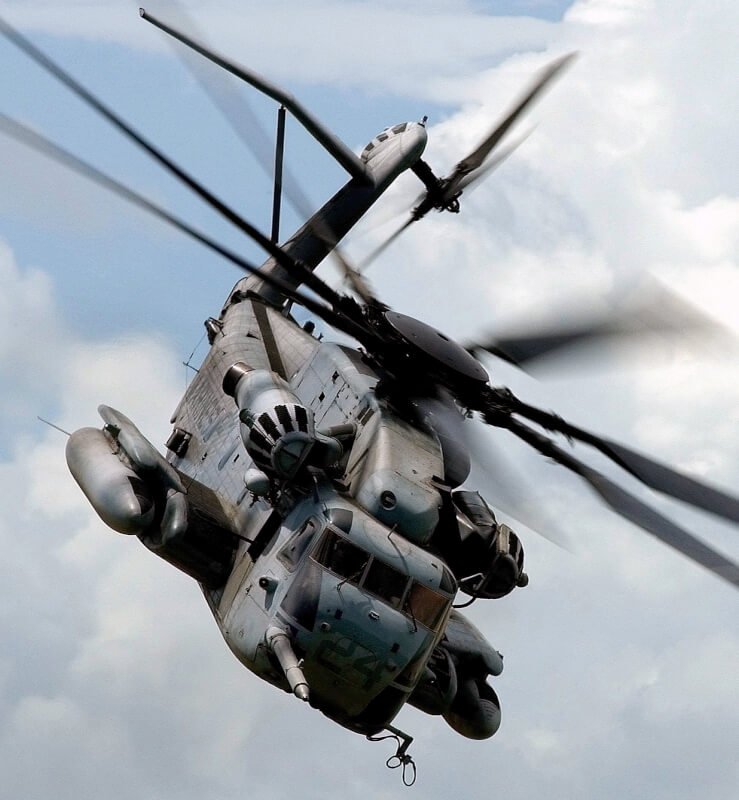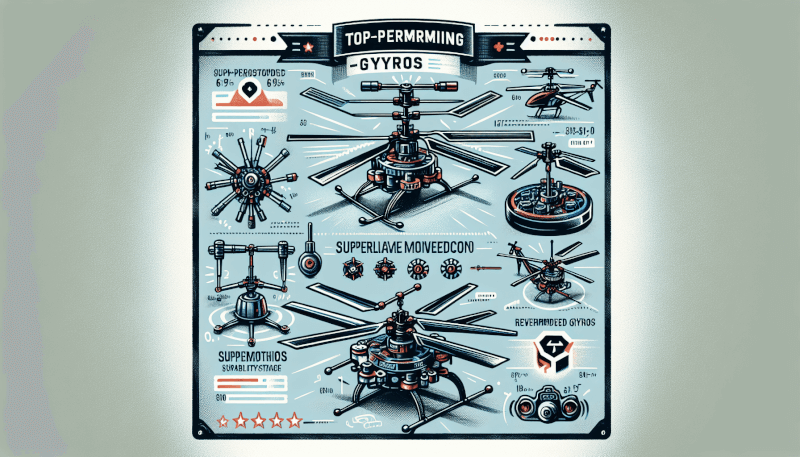Are you tired of constantly adjusting and struggling to stabilize your RC helicopter during flight? Look no further! In this article, discover the top-notch RC helicopter gyros that are guaranteed to improve stability and revolutionize your flying experience. Say goodbye to wobbly flights and hello to smoother landings with these superior gyros designed to enhance control and reduce vibrations. Whether you’re a beginner or an expert pilot, these cutting-edge gyros will take your RC helicopter flying to new heights. So, get ready for an effortless and thrilling ride as we explore the best RC helicopter gyros for improved stability.
What is an RC Helicopter Gyro?
Definition and Function
An RC helicopter gyro is an electronic device that plays a crucial role in stabilizing and controlling the flight of an RC helicopter. It is designed to counteract external forces such as wind gusts and disturbances, ensuring a smoother and more stable flight experience for the pilot.
The primary function of a gyro is to sense any unintended rotational movement of the helicopter and automatically adjust the control inputs to counteract it. By continuously monitoring the helicopter’s orientation and making rapid corrections, the gyro helps to maintain a level flight and prevent undesired movements, such as drifting or spinning.
Types of RC Helicopter Gyros
There are different types of RC helicopter gyros available in the market. Some of the most common types include:
Rate Gyros: Rate gyros measure the rotational speed of the helicopter and provide control inputs proportional to the rate of rotation. These gyros are known for their simplicity and affordability, making them a popular choice for beginners.
Heading Hold Gyros: Heading hold gyros, also known as heading lock gyros, not only sense the rate of rotation but also aim to maintain a specific heading or direction. They provide precise and stable control, making them suitable for advanced pilots or those looking for more precise maneuvering capabilities.
3-Axis Gyros: 3-axis gyros utilize advanced technology to sense rotation in all three axes of the helicopter: roll, pitch, and yaw. These gyros offer the highest level of stability and control, allowing for precise and smooth flight maneuvers.
Benefits of Using RC Helicopter Gyros
Improved Stability
One of the key benefits of using an RC helicopter gyro is the improved stability it provides during flight. The gyro’s ability to detect and counteract unwanted rotation helps to maintain a level flight path and prevent the helicopter from drifting or spinning. This stability makes it easier for pilots of all skill levels to control their helicopters and perform maneuvers with greater precision.
Enhanced Control
RC helicopter gyros offer enhanced control over the aircraft’s movements. By automatically adjusting the control inputs based on the helicopter’s orientation, gyros help pilots achieve more accurate and responsive maneuvering. Whether it’s executing sharp turns or maintaining a steady hover, the gyro ensures that the pilot’s commands are translated effectively, allowing for smoother and more controlled flight experiences.
Reduced Pilot Workload
With the assistance of an RC helicopter gyro, pilots can experience a reduced workload during flight. The gyro’s ability to automatically make corrections in response to external disturbances takes the burden off the pilot, allowing them to focus on other aspects of flying, such as planning maneuvers or monitoring the surroundings. This reduction in workload can be particularly beneficial for beginners who are still developing their flight skills or for experienced pilots who want to enjoy a more relaxed flying experience.

Factors to Consider When Choosing RC Helicopter Gyros
Compatibility with Helicopter Models
When choosing an RC helicopter gyro, it is essential to ensure compatibility with the helicopter model you own or plan to purchase. Not all gyros are compatible with all helicopter models, so it is crucial to check the manufacturer’s specifications and recommendations. Investing in a gyro specifically designed for your helicopter model will ensure optimal performance and compatibility.
Number of Axes
The number of axes supported by the gyro is another important consideration. While rate gyros may only sense rotation around one axis, heading hold gyros and 3-axis gyros offer control in multiple axes, providing more stability and maneuverability. Depending on your skill level and flying preferences, you may opt for a gyro that supports a single axis or go for the added stability and control offered by multi-axis gyros.
Gyro Sensitivity
Gyro sensitivity refers to how quickly and accurately the gyro detects and responds to changes in the helicopter’s orientation. Higher sensitivity allows for more precise control but can also increase the risk of overcorrections or oscillations. Finding the right balance of sensitivity based on your flying style and skill level is crucial to ensure optimal performance and flight experience.
Price
Price is another factor to consider when choosing an RC helicopter gyro. While it is always tempting to opt for the most affordable option, it is important to balance the price with the quality and features offered by the gyro. Investing in a reliable and reputable gyro may cost more initially but can save you from potential frustrations and issues down the line. Consider your budget and prioritize gyros that offer a good balance of performance and value for money.
Top-rated RC Helicopter Gyros
Brand A Gyro
Brand A is known for producing high-quality RC helicopter gyros that are favored by many hobbyists and professionals alike. Their gyro models consistently receive positive reviews and are considered top-rated in the industry.
Brand B Gyro
Brand B is another reputable manufacturer of RC helicopter gyros. Their gyros are known for their advanced features and precise control, making them a popular choice among experienced pilots who demand the utmost stability and performance.
Brand C Gyro
Brand C is highly regarded for its innovation and reliability in the RC helicopter gyro market. Their gyros boast cutting-edge technology and excellent build quality, providing pilots with enhanced stability and control during flight.

Brand A Gyro
Features
Brand A gyro offers a range of features that contribute to its outstanding performance and stability. These features include:
- Advanced 3-axis stabilization for precise control in all flight conditions.
- Auto-leveling capabilities to ensure stable flight even during wind gusts or sudden movements.
- Programmable settings to customize the gyro’s response and sensitivity based on personal preferences.
- Compact and lightweight design for easy installation in various helicopter models.
- Compatibility with a wide range of transmitter systems for seamless integration with existing setups.
Pros
- Excellent stability and control, even in challenging flight conditions.
- Easy to install and set up in different helicopter models.
- Versatile programming options for fine-tuning the gyro’s behavior.
- Durable construction ensures long-lasting performance.
- Compatible with popular transmitter systems for convenient integration.
Cons
- Higher price compared to some other gyro brands in the market.
- Programming and setup may require some technical knowledge.
Brand B Gyro
Features
Brand B gyro offers a host of features that cater to the needs of experienced pilots and enthusiasts seeking precise control and stability. These features include:
- Dual gain adjustment for fine-tuning the gyro’s response and sensitivity.
- Heading hold mode for maintaining a constant heading or direction during flight.
- High-resolution sensors for accurate motion detection and control.
- Compact and lightweight design for easy installation in various helicopter models.
- Compatibility with popular transmitter systems for seamless integration.
Pros
- Exceptional stability and control, even during aggressive maneuvers.
- Smooth and precise response to control inputs for enhanced maneuverability.
- User-friendly interface for easy programming and customization.
- Reliable performance in various flight conditions.
- Compatible with a wide range of helicopter models and transmitter systems.
Cons
- Slightly higher price point compared to some other gyro models in the market.
- May require some fine-tuning to achieve optimal performance.

Brand C Gyro
Features
Brand C gyro stands out with its innovative features and advanced technology, setting it apart from other options in the market. Some of its notable features include:
- Multi-axis stabilization for superior control and stability.
- Integrated vibration dampening system to minimize the impact of external vibrations on gyro performance.
- Adjustable gain settings for fine-tuning the gyro’s response and sensitivity.
- Lightweight and compact design for easy installation and integration.
- Wide compatibility with various helicopter models and transmitter systems.
Pros
- Exceptionally smooth and precise control, even in challenging flight conditions.
- Advanced vibration dampening system for improved gyro performance.
- Intuitive programming interface for easy customization and setup.
- High-quality construction ensures long-lasting durability.
- Widely compatible with popular transmitter systems and helicopters.
Cons
- Relatively higher price compared to other gyro brands on the market.
- Advanced features may require some time to fully understand and utilize.
Installation and Setup of RC Helicopter Gyros
Tools and Equipment Needed
Before installing an RC helicopter gyro, make sure to gather the following tools and equipment:
- Screwdrivers: You’ll need a set of screwdrivers to remove and install screws during the installation process.
- Double-sided tape or adhesive velcro: These will be used to securely attach the gyro to the helicopter’s frame.
- Cable ties: Cable ties can help with cable management and ensure a clean and organized setup.
- Gyro tape: Special gyro tape helps minimize vibrations and improve the gyro’s performance.
Step-by-Step Guide
- Locate a suitable mounting location for the gyro on the helicopter’s frame. The ideal position is usually near the center of gravity for optimal stability.
- Use the double-sided tape or adhesive velcro to attach the gyro securely to the frame. Ensure a solid connection without any excessive movement.
- Connect the gyro to the receiver using the provided cables, following the manufacturer’s instructions and the specific requirements of your helicopter.
- Route and tidy the cables using cable ties, securing them away from moving mechanical parts and ensuring they do not interfere with the helicopter’s operation.
- Apply gyro tape to the helicopter’s frame to further reduce vibrations and ensure accurate gyro readings.
- Power up the helicopter and gyro system, ensuring all connections are secure and functioning correctly.
- Access the gyro programming interface, either through a dedicated programming box or using the transmitter if supported.
- Set up the gyro’s basic functions, including channel assignment, gyro direction, and mode selection, according to the manufacturer’s instructions.
- Fine-tune the gyro’s gain settings, sensitivity, and response to achieve the desired flight characteristics. This step may require some experimentation and test flights to find the optimal settings for your flying style and conditions.
- Conduct a thorough pre-flight check to ensure all gyro settings and connections are correct before taking off.

Tips for Maximizing Stability with RC Helicopter Gyros
Proper Center of Gravity
Maintaining the proper center of gravity is crucial for maximizing stability when using an RC helicopter gyro. Ensure that the helicopter’s weight is distributed evenly and that the rotor blades and other components are aligned correctly. Any imbalance in weight or improper alignment can affect the gyro’s ability to stabilize the helicopter, leading to decreased performance and stability.
Calibration and Tuning
Taking the time to calibrate and fine-tune the gyro’s settings can significantly enhance stability and control. Follow the manufacturer’s instructions for calibrating the gyro and adjusting the gain settings and sensitivity to suit your flying preferences. Experiment with different settings and make small adjustments until you achieve the desired level of stability and control during flight.
Maintenance and Upkeep
Regular maintenance and upkeep are essential for ensuring optimal performance and stability with RC helicopter gyros. Clean the gyro and its connections regularly, checking for any dust or debris that may affect its performance. Additionally, inspect the gyro’s cables and connectors for any signs of wear or damage, as these can compromise stability and safety during flight. Stay up to date with any firmware updates or software upgrades provided by the manufacturer to benefit from performance improvements and enhanced stability.
Conclusion
RC helicopter gyros offer significant benefits in terms of stability, control, and reduced pilot workload. With their ability to counteract unwanted rotation and make rapid adjustments, gyros improve the overall flying experience for pilots of all skill levels. When choosing an RC helicopter gyro, consider factors such as compatibility, number of axes, sensitivity, and price to ensure the best fit for your needs. Top-rated brands, including Brand A, Brand B, and Brand C, offer a range of features and performance levels to cater to different pilot preferences.
By following the installation and setup guide and considering tips for maximizing stability, pilots can harness the full potential of their RC helicopter gyros. Proper center of gravity, calibration, and regular maintenance are crucial for ensuring optimal performance and stability. With the right gyro and careful attention to these factors, pilots can enjoy a stable, controlled, and smooth flight experience, whether they are beginners or experienced RC helicopter enthusiasts.



